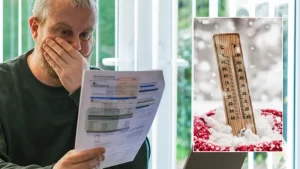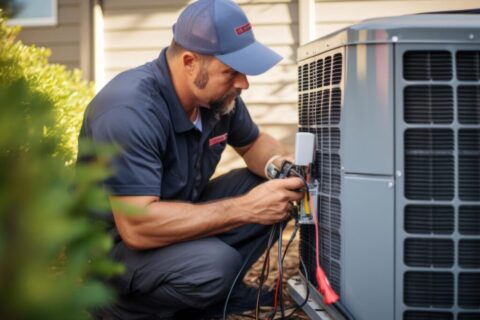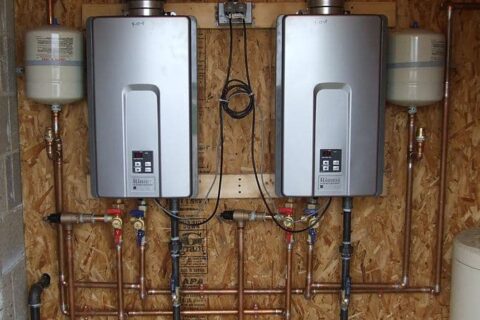Strategic Thermostat Placement: Tips to Lower Energy Bills
Key Takeaways
-
Thermostat location plays a pivotal role in energy efficiency, comfort, and utility savings. Placing it in the right spot can save money on energy bills and help your HVAC system work more efficiently.
-
Avoid locating thermostats in the path of direct sunlight, heat sources, windows, and drafts. Proper thermostat placement allows for the most accurate temperature reading and operation of the system.
-
Locate and install the thermostats on interior walls away from direct sunlight. Mount them 5 feet off the ground for maximum comfort, temperature control and easy operation.
-
Consider the layout of your home as well as how you use each room. Select a location that encourages balanced airflow and energy consumption throughout the home.
-
Complete thermostat placement with other energy-saving strategies such as sealing air leaks, improving insulation and using programmable or smart thermostats.
-
Routine maintenance and filter replacement of HVAC systems helps improve overall thermostat efficiency and can help HVAC systems last longer.
A lot of the time, lowering energy bills is easier than it looks. Smart thermostat placement is essential to getting the best heating and cooling performance out of your home.
Placing the thermostat in the proper location will get you the most accurate temperature readings possible, allowing your HVAC system to operate at optimal efficiency. Locations out of direct sunlight, drafts or heat from appliances work best for optimum performance.
For instance, locating it on an interior wall close to the center of your home allows for more even overall temperature control. Tiny tweaks like these reduce wasted energy and help you feel more comfortable at home.
Through thoughtful placement and design, you can save money while maximizing your energy efficiency without compromising your comfort.
Importance of Thermostat Placement
Properly locating your thermostat can help your heating and cooling systems run much more efficiently. This small change can save big on energy costs! Installed in the right position, it allows your residence to maintain a consistent temperature while using less energy.
Placing it in the wrong location can result in increased bills and an uncomfortable environment.
Why Placement Affects Energy Efficiency
The thermostat does this by sensing the temperature of the air around it. If your system is located close to other heat sources, like a stove or a lamp, it will receive false readings. This can make your system work unnecessarily harder to cool the space.
Having drafts from windows or doors close to your thermostat can mislead it. Consequently, it can cause the system to believe the space is much colder than it is. This mismatch leads to your HVAC system running more than it’s supposed to, using excess energy.
The location of your thermostat also affects how quickly it detects temperature changes. This is important for keeping your home comfortable and saving energy.
Common Mistakes in Thermostat Placement
Don’t put your thermostat next to a window or door. Drafts from these areas can greatly skew the temperature readings. Direct sunlight is the other issue. Sunlight can artificially heat up the thermostat, causing your AC to work unnecessarily hard.
High-traffic areas aren’t suitable locations either as busy foot traffic will create varying temperatures from movement. Don’t put it in direct sunlight or next to heat generating appliances like ovens, microwaves or TVs.
This will enable you to identify how you may be using energy unnecessarily.
Benefits of Strategic Thermostat Placement
Aside from saving you money, a well-placed thermostat improves your energy efficiency by preventing your HVAC system from having to overcompensate. It prevents hot and cold spots, keeping rooms warmer in the winter and cooler in the summer, creating a more comfortable living space.
Additionally, your HVAC system will last longer because it’s not running on days it doesn’t need to. What you get with smart thermostat placement is smarter control of your home’s climate.
This provides more flexibility to achieve a comfortable, warm atmosphere.

How to Position Thermostats Effectively
1. Avoid Direct Sunlight and Heat Sources
If you put your thermostat in direct sunlight or near an appliance that generates a lot of heat, it will skew temperature readings. This can cause incorrect readings of the indoor temperature. Sunlit locations or places around a range or oven can create inaccurate readings.
This causes your HVAC system to unnecessarily overwork and use excess energy. Rather, look for shaded areas in your house, particularly those that are not affected by outside temperature changes. For example, a thermostat located in a hallway away from drafts and windows usually provides more stable readings.
2. Place Away from Drafts and Windows
Cold drafts from windows and doors can affect your thermostat’s temperature reading, causing your heating system to run more than it needs to. By placing the thermostat away from windows, you minimize the impact of drafty windows or cold spots.
Think about locations such as the interior wall of a room that almost never has its door or window open. In multi-story homes, avoiding placement near large, drafty windows on each floor helps ensure stable comfort and temperature readings on each floor.
3. Install on Interior Walls
Interior walls offer much more control over the ambient environment in which your thermostat sits. Exterior walls are subject to heat and cold bleed from the exterior walls. Conversely, using interior walls allows your thermostat to truly hone in on the indoor climate.
Preferably, these walls should be located in a central location to detect airflow across the space evenly. For instance, an inside wall in the living room or main hallway is ideal.
4. Maintain Proper Height from the Floor
When it comes to where to install a thermostat, height is important. Mount it between 52 and 60 inches above the floor—about at the average person’s eye-level. Positioning it too low can lead to cooler air readings, whereas above 60 inches can overstate warmth.
Maintaining it at this height allows for more accurate readings and easier access.
5. Ensure Accessibility for Adjustments
Make thermostats easy to floor reach by everyone in the household. Don’t install them behind furniture or in other difficult to reach areas. For all the convenience of remote access through smart thermostats, ease of access isn’t just a smart feature, it’s a necessity.
Positioning at eye level makes for a more user-friendly thermostat, encouraging frequent adjustments to save energy.
Factors to Consider for Placement
Home Layout and Room Usage
The physical arrangement of your house is one of the biggest factors that affect how well your thermostat works. Airflow and temperature distribution can differ greatly depending on room sizes and configurations. For example, open-concept spaces may be able to better regulate their temperature than smaller, walled-in spaces.
Rooms with more intensive use, such as living rooms or kitchens, may require placement closer to the thermostat to create adequate comfort. Installing the thermostat in a central, interior location—like a hallway or other shared area—keeps everyone reading from the same page.
Avoid areas where temperature is inconsistent, like by a window or a drafty entrance. In this manner, you can maximize your temperature upgrades to be spot on. A height of 52-60 inches above the floor will also help ensure that the thermostat does not get ‘pockets’ of hot or cold air.
HVAC System Type and Design
Your HVAC system’s design will play a role in where your thermostat should go. For systems such as central air or forced-air heating, it may function most efficiently with thermostats set where the manufacturer recommends.
Putting the thermostat by an air return vent is a good idea. It provides for the thermostat to accurately detect the average temperature of the room instead of only responding to the immediate result of the system. Compatibility is important too—most modern smart thermostats need compatible wiring or system settings to work effectively.
Putting the thermostat on the first floor of a two-story home uses heat’s natural inclination to rise to your advantage. This configuration helps with temperature control across the home.
Temperature Variations in the Home
Temperature can vary significantly from room to room based on differences in insulation or sun exposure. Monitoring these variations can help point to areas where more fine-tuned control is necessary.
As an example, bedrooms that face the sun will be warmer, while other rooms that are shaded will be cooler. Having several thermostats or smart sensors can make up for these variations.
This one stops shoving sanity out the door. It saves homeowners an average of 40% on their home energy bills by better matching heating and cooling to actual demand.
Complementary Energy-Saving Strategies
Use Programmable or Smart Thermostats
Programmable and smart thermostats are one of the best energy efficiency tools. With a programmable thermostat, you can automate temperature adjustments to occur automatically throughout the day. With a smart thermostat, you can automatically reduce heating or cooling when the house is vacant or at night.
Smart thermostats take it even further by giving you remote access through a smartphone app. This means that you can make changes on the fly, even from away from home. Most smart models learn your habits over the course of a day.
They develop individualized schedules that keep people comfortable—automatically—and use energy only when absolutely needed. By taking full advantage of the scheduling features, households can reduce annual heating and cooling costs significantly, making these devices a worthwhile investment.
Seal Air Leaks and Insulate Properly
Air leaks, which are commonly located around windows, doors, and attics, can cause up to 30 percent of energy loss. Sealing these gaps with caulking or weatherstripping will eliminate drafts and make sure all that expensive conditioned air stays inside.
Proper insulation goes a long way in continuing that temperature balance and keeping the load off of your HVAC system. When combined, duct sealing and insulation can save homeowners up to 20% on heating and cooling costs.
For the average household, this translates to energy savings of $220 to $330 annually. Combining these measures with strategic thermostat installation helps ensure these measures are as effective as possible by maintaining an even temperature throughout the home.
Optimize HVAC Maintenance and Filters
Taking care of your HVAC system through routine maintenance helps it save energy as well. Replacing filters monthly enhances airflow, which can increase system efficiency by 5–15%.
When paired with a clean, well-maintained HVAC unit and a strategically placed, high-quality thermostat, you can have accurate, energy-efficient temperature control. Regular system checkups catch issues that can make your energy bills spike, so you can make sure your system is running as efficiently as possible.
Use Ceiling Fans for Better Air Circulation
Ceiling fans may seem basic but they’re an efficient way to distribute air. In winter, using fans on reverse (clockwise) pushes warm air down from the ceiling. This simple move can reduce your heating requirements by as much as 4°F.
When paired right, this can add up to significant savings with no loss of comfort. In summer, fans can help keep you cool with a cooling breeze, which means less need to crank up the air conditioning.
Adding fans to your energy-saving strategies improves circulation. It works in tandem with your thermostat to create a smarter, more efficient system.
Benefits of Lower Energy Bills
Reduced Monthly Utility Costs
Saving on energy bills begins with taking inventory of your utility costs. This provides an excellent snapshot of the impact thermostat placement can have on your home’s energy use.
Put the thermostat out of direct sunlight or heat drafts. This precise positioning allows it to sense the room temperature accurately and avoid heating or cooling when it’s not needed. Making modest changes, such as wearing warmer clothing and adjusting your thermostat to 68°F in the winter and 78°F in the summer, save you money.
Though minor, these changes can wrap around the bills to become significant savings. Eventually, even a modest 5% decrease in energy consumption can translate into significant savings on your monthly bill. This month, take some simple energy-efficient steps to save money! For instance, set your thermostat to cooler temps at night, so you’re not wasting money on energy you’re not using.
Improved Home Comfort and Air Quality
A properly located thermostat is essential for energy saving and does more than just save money; it also ensures a consistently comfortable home. By positioning the thermostat away from drafty areas or spots where the temperature might suddenly spike, you enhance the accuracy of readings and maintain better temperature control. This results in fewer sudden cold blasts in winter or uncomfortable heat in summer, contributing to a more efficient HVAC system.
Moreover, improved air quality and lower humidity levels can lead to substantial energy savings while keeping the indoor temperature stable. For example, maintaining a consistent set temperature of 72°F can effectively prevent mold growth, which thrives in unstable conditions. This creates a healthier and more comfortable living environment for everyone in your household throughout the year.
Utilizing smart home devices, such as programmable thermostats, can further optimize your home’s temperature settings. By integrating these technologies, you enhance energy efficiency measures that lead to reduced energy bills and improved HVAC performance, ensuring a comfortable atmosphere year-round.
Positive Environmental Impact
When we use less energy, we put less strain on the environment. Making cuts on heating and cooling not only saves you money, it helps lower your home’s carbon footprint, contributing to a more sustainable future.
When these energy-efficient practices are adopted by the whole community, the sum of the parts has even more of an effect. Even small actions, such as lowering thermostats, save money and energy while helping to create a cleaner, brighter future for all Americans.
Conclusion
Proper thermostat placement is one simple way to mitigate your energy bills. Even simple things such as keeping furniture or window treatments away from direct sunlight or drafts can keep your HVAC system running its best, saving you money. When paired with other energy-saving habits, such as sealing drafty windows or using ceiling fans, the savings multiply.
Lower energy bills leave you with more savings to spend on what you love. It’s more than a comfort thing—it’s being smart with your home, and smart with your money. It all adds up, but now you know how to get started.
Take a look around your home, make some changes, and enjoy the savings. With strategic thermostat placement and a little bit of adjustment, you’ll get a more comfortable environment without the expense.
Frequently Asked Questions
Why is thermostat placement important?
Thermostat placement significantly affects the performance of smart home devices, as improper positioning can cause energy waste and higher energy costs, while correct placement enhances energy efficiency measures and ensures a comfortable living environment.
Where should I place my thermostat for the best results?
Ensure your smart thermostat is mounted on an interior wall, away from direct sunlight, windows, doors, and vents, to improve energy efficiency measures and sense the indoor temperature more accurately.
Can placing a thermostat near a heat source increase energy bills?
Installing a thermostat next to heat-producing appliances like ovens or space heaters can lead to inaccurate temperature readings, resulting in overcooling and increased energy costs due to inefficient energy usage and higher bills.
Should I avoid placing a thermostat in direct sunlight?
Direct sunlight can artificially inflate your thermostat’s reading, making your home environment feel warmer than it actually is, which can lead to overcooling and increased energy costs.
How does thermostat placement affect energy savings?
Proper placement of your smart thermostat allows it to accurately measure the room temperature, enhancing HVAC performance, which can lessen the strain on your system, reduce energy usage, and save on energy costs.
What complementary strategies can help lower energy bills?
Other ways to save include using smart devices like programmable thermostats, sealing air leaks, and insulating your home. These energy saving features, along with strategic thermostat placement, enhance energy efficiency.
Can thermostat placement improve comfort at home?
You bet, a strategically placed smart thermostat will help your heating and cooling system maintain a steady temperature, enhancing thermal comfort and promoting substantial energy savings.


